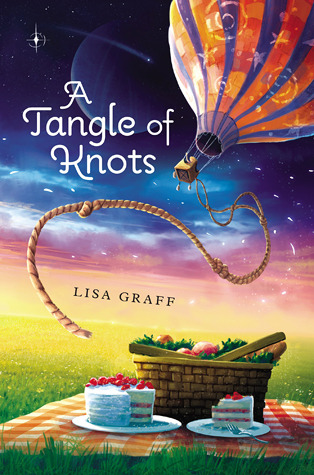 <Movie preview voice>
<Movie preview voice>IN A WORLD divided between those with special "Talents" and those who are merely "Fair," a mystery is waiting to be unraveled.
</Movie preview voice>
Eleven-year-old Cady is in the first group. Not only does she bake extraordinary cakes, she can ascertain a person's ideal variety of cake just by looking at them. She wins a lot of baking contests. Marigold Asher, on the other hand, is the only Fair member of a Talented family. She spends a lot of time looking for her Talent. And then there's the cantankerous Owner of the Lost Luggage Emporium, above which Cady and Marigold both find themselves living. And the tall stranger in the hot air balloon. And the lost woman known only as "V." And the rest of Marigold's family, and the orphanage owner, and...
Are you getting that this is an ensemble book?
A Tangle of Knots had two factors working against it for this reader:
1. People With Special Talents. They seem like this decade's middle grade equivalent of Zombie Angel Vampires.
2. Recipes Included. Polly Horvath did it well in Everything on a Waffle and spawned an army of imitators.
Despite my reservations, though, I felt myself being drawn into Graff's world. I'm a sucker for an intricate plot, and this one provides an impressive puzzle. The title is apt - I found myself frequently flipping back to previous chapters to untangle various plot points. And it's one of those books where all of the pieces fit together in the end with a satisfying click.
On the other hand, it takes time to put in place all the strands of a plot this complicated. In a middle grade book that clocks in at 229 pages, the whole thing felt overly rushed. The characters are underdeveloped, and I had no sense at all of the setting. Thematically, it raised some interesting questions (does Talent equal destiny, or is it just a distraction?) and then left them frustratingly unanswered. I was left with the sense that Graff was a Talented juggler with too many balls in the air, and all of her authorial energy went towards keeping them aloft.
It's still a terribly enjoyable book. I wouldn't call it Distinguished, but for readers who prefer plot over character or setting (and there are many), I give A Tangle of Knots an enthusiastic thumbs up.
Publication in February 2013 by Philomel Books





